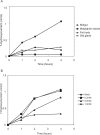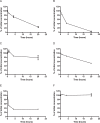Pharmacokinetics of anti-infectious reagents in silkworms
- PMID: 31263251
- PMCID: PMC6602958
- DOI: 10.1038/s41598-019-46013-1
Pharmacokinetics of anti-infectious reagents in silkworms
Abstract
Silkworm microorganism infection models are useful for screening novel therapeutically effective antimicrobial agents. In this study, we used silkworms to investigate the pharmacokinetics and metabolism of antimicrobial agents, in which cytochrome P450 plays a major role. The pharmacokinetic parameters of the antimicrobial agents were determined based on their concentrations in the hemolymph after administration. The parameters, such as half-lives and distribution volumes, in silkworm were consistent with those in mammalian models. In addition, antifungal agents with reduced therapeutic effectiveness due to high protein-binding capacities in mammalian serum exhibited similar features in silkworm hemolymph. Cytochrome P450 enzymes, which metabolize exogenous compounds in mammalian liver, were distributed mainly in the silkworm midgut. Most of the compounds metabolized by cytochrome P450 in humans are also metabolized in the silkworm midgut. These findings suggest that the pharmacokinetics of antimicrobial agents are fundamentally similar between silkworms and mammals, and that therapeutic effects in the silkworm infection model reflect the pharmacokinetics of the test samples.
Conflict of interest statement
K.S. is a consultant for Genome Pharmaceutical Institute Co., Ltd.
Figures



References
Publication types
MeSH terms
Substances
LinkOut - more resources
Full Text Sources

